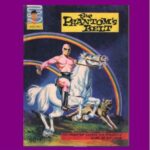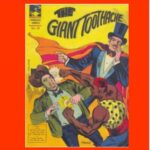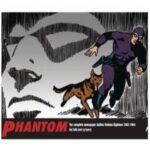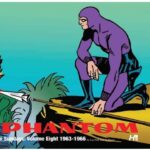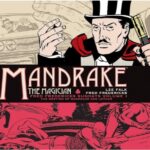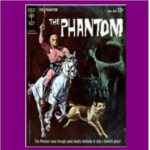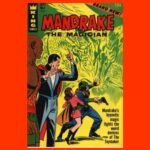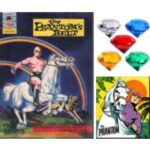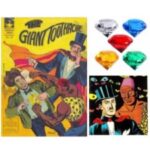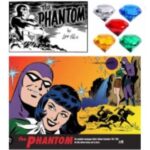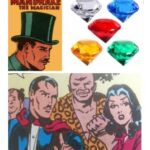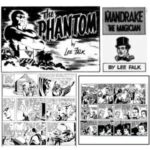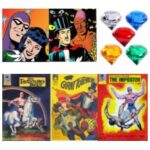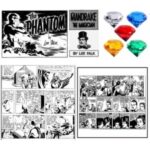Clicking on the following links or images will take you to the Phantom or Mandrake comic collections covered in this section:
The Phantom and Mandrake the Magician are two of the most iconic characters in comics and they have also had the most longevity compared with any other comic character. Both made their debut in newspaper comic strips in the mid-1930s, and these newspaper strips continue until the present day. Mandrake was introduced in 1934 and the Phantom followed shortly thereafter, in 1936. Both characters were created by Lee Falk, and it is a testament to Falk’s genius that even today, over eight decades later, these two characters are among the most recognizable in the medium of comics. (Note: For more interesting details on Lee Falk, please check out this post.)
Mandrake the Magician is widely regarded by comics historians as the first comic-book super-hero, i.e., a character who has special powers or skills beyond those of normal humans. On the other hand, the Phantom was the first fictional hero to wear the skintight costume which has became a hallmark of comic-book super-heroes, and he was also the first shown in a mask with no visible pupils. The latter has become a standard for nearly all masked super-heroes who followed, most notably Batman. Both of Lee Falk‘s creations were truly groundbreaking, and they set the stage for the super-hero era which took off in the late 1930s.
Another remarkable thing about Lee Falk is that he personally scripted both the daily and Sunday newspaper stories featuring the Phantom and Mandrake for over six decades, starting from the creation of the two characters in the mid-1930s until his death in 1999. He was so dedicated to the comic strips that even on his death bed, he took off his oxygen mask and dictated his last Phantom stories to his wife Elizabeth during her visits to see him at the hospital!
Unlike other super-heroes, both the Phantom and Mandrake have appeared primarily in newspaper strips rather than comic books. Most comic books featuring the Phantom and Mandrake contain slightly reformatted/rearranged versions of the newspaper stories, though there are a few original stories that have been created directly for comic books. There are two categories of Mandrake and Phantom newspaper strips: (a) daily stories (usually in black and while) and (b) Sunday stories (usually in color). These two categories of strips generally follow independent story arcs, though sometimes when there is a major milestone (such as the Phantom getting married), both strips share a common storyline. In my lists, I have included every original daily and Sunday story ever published for each character.
Considering his long writing career of 60+ years, Lee Falk partnered with relatively few artists for his newspaper strips, as they each had very long tenures. For his Mandrake stories, he started with Phil Davis, who drew Mandrake for 30 years until his death in 1964. The art was then taken over by Fred Fredericks, who outlasted Falk and even took over the scripting after Falk’s death in 1999. Fredericks produced original Mandrake stories until 2002, and after that the newspaper strips started reprinting previously published stories. It is amazing that over nearly 70 years of original Mandrake strips, there were only two artists (and only two writers, counting Falk himself)!
The first newspaper strips featuring the Phantom were drawn by Ray Moore, who started as an assistant to artist Phil Davis on Falk’s Mandrake strip. In 1949, Moore was succeeded by Wilson McCoy, who drew the strip until his death in 1961. The artwork was then taken over by Sy Barry, who became the definitive Phantom artist and whose portrayal of the Phantom is the most recognizable and set the standard for all the others who followed. After Barry retired in 1994, various other artists took over the artwork for the strips. It is noteworthy that for the six decades following his introduction, the Phantom strips were written by their creator Lee Falk and drawn by just three artists, each with his own unique style: Ray Moore, Wilson McCoy and Sy Barry.
The Phantom mythology created by Lee Falk is truly fascinating, and it is remarkable that the essence of the character has not changed in nearly a century. (The same is true for Mandrake as well.) The Phantom is hugely popular all over the world, especially in South Asia, Australia and the Nordic countries. Most Indians (like myself) were introduced to the Phantom as well as Mandrake through Indrajal Comics, which started publication in March 1964 and is the oldest indigenously produced comic book in India. These comics are beloved by Indians across the world who grew up between the 1960s and the 1980s. (They were published in multiple Indian languages, which added to their attraction.) The vast majority of the Indrajal comic books contained reprints of the daily and Sunday stories (usually with new titles), though the covers had original artwork by Indian artists (most notably B. Govind).
Starting in 1966, the Indrajal issues began to include Mandrake and Phantom stories from other sources such as Gold Key, King and Charlton comics. In my opinion, the quality of the Gold Key and King stories is pretty good (though they depart from Lee Falk’s signature style on the newspaper strips), but I find the Charlton Phantom stories to be very unappealing, with poor writing and art. Thus, although I have included the Charlton stories on my Indrajal lists for completeness, I have excluded them in the ‘Other Comics’ subsection, as they are definitely not to my taste.
In addition to the above, there have been many original Phantom stories printed in the Swedish comic-book series Fantomen, which started publication in 1952. These stories are generally of high quality and have been translated into many languages all over the world. Some of the best Fantomen stories have been reproduced in the Egmont series in India as well as in Frew Publications in Australia, the latter being the oldest Phantom comic-book series continuously in publication (since 1948). Finally, there are some great modern Phantom stories published in the Moonstone series, which are well worth reading.
For more information about the Phantom and Mandrake, check out these fan sites: Phantom Fandom and Mandrake Fandom.

